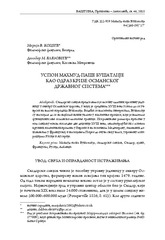Uspon Mahmud-paše Bušatlije kao odraz krize Osmanskog državnog sistema
The rise of Mahmud pasha Bušatlija as the reflection of the crisis of the Ottoman state system
| dc.creator | Kocić, Marija | |
| dc.creator | Elezović, Dalibor M. | |
| dc.date.accessioned | 2021-10-12T12:39:37Z | |
| dc.date.available | 2021-10-12T12:39:37Z | |
| dc.date.issued | 2018 | |
| dc.identifier.issn | 0353-9008 | |
| dc.identifier.uri | http://reff.f.bg.ac.rs/handle/123456789/2482 | |
| dc.description.abstract | Skadarski sandžak predstavljao je zasebnu administrativnu jedinicu u okviru Osmanskog carstva, u kojoj je sredinom XVIII veka uspela da se učvrsti na vlasti porodica Bušatlija. Vodeći se vlastitim interesima, Bušatlije su nastojale da se na najbolji način uklope u političke procese, koje je nametalo funkcionisanje osmansko-mletačke granice. Istraživanje razmatra prilike u tom sandžaku tokom poslednje dve decenije XVIII veka, analizirajući ih s aspekta krupnih političkih promena u Evropi i na istočnom Mediteranu, izazvanih dešavanjima u Francuskoj i nastojanjem Porte da očuva svoju vlast, ugroženu aspiracijama Rusije i Austrije. | sr |
| dc.description.abstract | In the last decades of the eighteenth century, the Porte endeavoured to preserve the control over the territory endangered by the particularistic tendencies of the provincial administrators, which marked the period of Ottomans history known as period of ayans. Mahmud-pasha Bušatlija (1779-1796), who at certain moments managed to establish independent power in the Sanjak of Scutari, belonged to this milieu. The Venetian and French sources provide a new light in interpreting the position and behaviour of Sanjak-bey of Scutari Mahmud-pasha Bušatlija. Aware of the position in which the Ottoman state found itself, he subordinated the Sultan's interests to the regional, trying to establish an independent authority in the relation to the Porte in the area that was entrusted to him. In this, he was helped by the occurrence that was happening in Europe, in which relations were shaken by the consequences of the French revolution. In that period, the Ottoman state was confronted with the intentions of Austria and Russia to reduce its territory in the Balkans, but also by the rebellions in the eastern provinces, which was the by-product of the rise of the new ruling dynasty in Persia. However, the strengthening of the movement of Ali-pasha, another Albanian rebel, which, as time will show, was much more serious and with deeper consequences on the international plane, the hands of the Porte remained tied in the final settlement with the Scutari Sanjak-bey, which for the second time offered him forgiveness in 1795. The choice of the priorities that needed to be resolved certainly influenced the Porte's decision at a time when a much greater danger to the Ottoman state came from the surrounding of Edirne, where the Ali Pasha Tepeleni movement was strengthened, and also from Russia, which sought to obtain the epithet of the Mediterranean force by opening the Straits and through occupation of maritime bases in the Mediterranean. | en |
| dc.publisher | Institut za srpsku kulturu Priština, Leposavić | |
| dc.relation | info:eu-repo/grantAgreement/MESTD/Basic Research (BR or ON)/177009/RS// | |
| dc.rights | openAccess | |
| dc.rights.uri | https://creativecommons.org/licenses/by/4.0/ | |
| dc.source | Baština | |
| dc.subject | skadarski sandžak | sr |
| dc.subject | Skadar | sr |
| dc.subject | Rusija | sr |
| dc.subject | Mahmud-paša Bušatlija | sr |
| dc.subject | Francuska | sr |
| dc.subject | Albanci | sr |
| dc.subject | ajani | sr |
| dc.subject | Scutari sanjak | en |
| dc.subject | Scutari (Scodra) | en |
| dc.subject | Russia | en |
| dc.subject | Mahmud-pasha Bushatli | en |
| dc.subject | France | en |
| dc.subject | ayans | en |
| dc.subject | Albanians | en |
| dc.title | Uspon Mahmud-paše Bušatlije kao odraz krize Osmanskog državnog sistema | sr |
| dc.title | The rise of Mahmud pasha Bušatlija as the reflection of the crisis of the Ottoman state system | en |
| dc.type | article | |
| dc.rights.license | BY | |
| dc.citation.epage | 306 | |
| dc.citation.issue | 46 | |
| dc.citation.other | (46): 291-306 | |
| dc.citation.rank | M51 | |
| dc.citation.spage | 291 | |
| dc.identifier.doi | 10.5937/bastina1846291K | |
| dc.identifier.fulltext | http://reff.f.bg.ac.rs/bitstream/id/1202/2479.pdf | |
| dc.type.version | publishedVersion |

